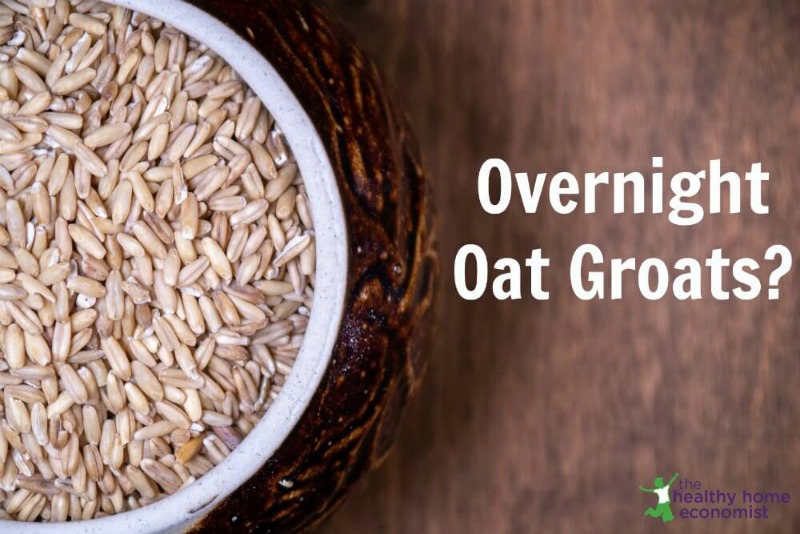
When the weather turns cold, a hot breakfast such as overnight oats tends to be the most appealing first thing in the morning.
The question is, what type of oats are best to use?
While rolled oats are most popular, there are other options too including steel-cut (Irish) oats, stone-ground (Scottish) oatmeal, or completely uncracked oat groats.
Because groats are in whole form, some people assume that this is the healthiest way to consume oats. But is this really true?
What are Oat Groats?
Groats are the whole seeds of a cereal or cereal-like grain. The germ, fiber-rich bran and endosperm are all intact within each kernel.
Rye and wheat groats are more commonly referred to as berries.
After removing the inedible hull, groats are firm and chewy when cooked which makes them popular as porridge and in soups.
Are Groats Healthy?
Oat groats are very healthy, however, the three best options for making oatmeal are steel cut, stone-ground or rolled oats only.
It is best to skip the oat groats.
The reason is that traditional preparation of oat groats is tricky. The end result will either take too long by modern standards or taste too sour.
I explain this in detail below.
Soaking Oat Groats
Oats are very high in anti-nutrients, particularly phytic acid. Wise preparation to eliminate these substances that block mineral absorption and irritate the gut ideally involves soaking followed by thorough cooking.
Toasting oats for granola is not a sufficient cook, by the way.
Some people stir in a bit of buckwheat flour to the soaking water to add the enzyme phytase which reduces phytic acid even more effectively.
Successful soaking requires that grain kernels be fully hydrated for a period of time at room temperature. It is important to never soak in the refrigerator as this hinders the breakdown of anti-nutrients.
Rolled, stone-ground or steel-cut oats only require an overnight soak to accomplish this goal. Oat groats, on the other hand, need several days to accomplish the same thing.
Anyone who has soaked grains before knows that after about 24 hours, things get dicey.
At best, 2-3 days of soaking grain results in an extremely sour taste once cooked that most people find unappealing.
At worst, soaked groats get moldy beyond 24 hours. Then, all you can do is throw them out or toss in the compost pile.
Thus, in my opinion, soaking groats is not advisable for porridge or soups. It does, however, work great for making homemade soaked oat milk.
Sprouting Groats
Rolled oats, steel-cut, or otherwise cracked oats will not sprout. This is because the delicate endosperm is damaged in the process.
Only whole oat groats will sprout.
That said, even whole oat groats with the hulls removed do not sprout very well if at all. This is because even the simple process of hulling the oat seeds can damage the endosperm.
For best results, it is best to sprout oat groats that are still in the hull.
The problems don’t end there!
Sprouting hulled oats is time-consuming, again taking at least a day or two to accomplish. What’s more, it is difficult to remove the hull after sprouting. This adds even more manual time to the process.
For these reasons, I do not recommend sprouting oat groats yourself even though technically it can be done.
Oat Groats vs Steel Cut
If you like the texture of oat groats opposed to the softer feel of rolled oats when cooked, then I would suggest using steel cut or Irish oatmeal instead. Stoneground Scottish oatmeal is another good choice.
If you prefer not to soak, sprouted steel-cut oats are available. These can be cooked and eaten immediately.
Even when fully soaked or sprouted and then cooked, steel-cut oats have a firm and chewy texture that oat groat lovers should find satisfying.
Note: I do not recommend quick cook steel-cut oats, as the cooking time is not sufficient to render the oats fully digestible even after soaking.
What Should I Do with my Oat Groats?
Do you have a good supply of oat groats on hand? Instead of using them for breakfast cereal, I suggest grinding them into oat flour and use for baking.
Warning: a sizeable percentage of gluten-sensitive and Celiac people react to the protein avenin in oats. This protein is difficult to digest and gluten-like, which is why some countries do not allow oats labeled as gluten-free even if processed in a certified GF facility.








I ferment a big batch of oat groats and keep it in the fridge. Smells just like yogurt.
I wonder if oat groats should be rinsed before cooking?
Thanks for the tips about filtered water, and non-metal spoon. I’m giving up on the aluminum-pot rice cooker though, it just sticks too much, every time. I have one of the old Hamilton Beach Crock Watcher 4 quart crock pots. 4 qt. is way big, but I’ll try it to see if it will work w/o sticking. Don’t have the owners manual, what setting do you recommend (low, high, Autoshift)? If that won’t work, maybe I will just cook the buckwheat groats in a small glass pot after soaking overnight on the stovetop.